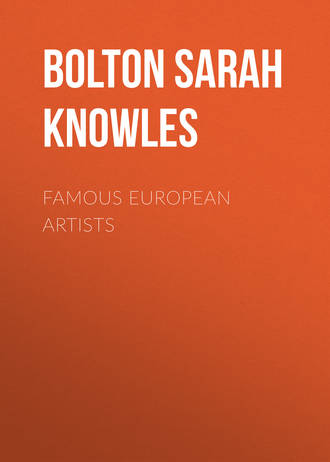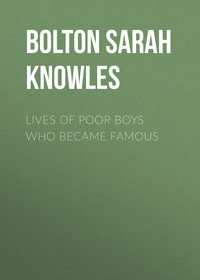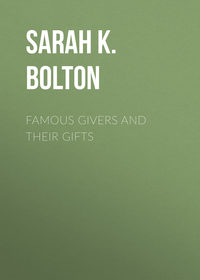 полная версия
полная версияFamous European Artists
In 1780, Sir Joshua painted the ladies Maria, Laura, and Horatia Waldgrave, grand-nieces of Horace Walpole. "He never had more beautiful sitters," says Leslie; "and in none of his pictures has he done more justice to beauty. Their bright faces are made to tell with wonderful force, by the white dresses and powdered têtes worn by all three. They are sitting round a work-table. Lady Laura, in the centre, winds silk on a card from a skein held by Lady Horatia; while Lady Maria, on the right, bends over her tambouring frame. The action admits of a natural arrangement of the heads, in full-face, three-quarters, and profile; and it is impossible to conceive an easier, prettier way of grouping three graceful, high-bred young ladies." At this time, all three of these young ladies were in sorrow. The young Duke of Ancaster, to whom Horatia was betrothed, had just died suddenly, and two prominent lords to whom the other sisters were engaged had broken their promises. Lady Maria married, four years later, the Earl of Euston; Laura, her cousin, Lord Chewton; and Horatia, Lord Hugh Seymour.
Sir Joshua painted two years later the beautiful but unhappy Mrs. Musters, whose son John married Mary Chaworth, Byron's first love. "The fine full-length of her as Hebe, with the eagle, still hangs at Colwich Hall. Another full-length, with a spaniel at her feet, painted in 1777, the year of her marriage, is at Petworth. It is interesting to compare the two, and note the wear and tear of five years in the reign of a queen of fashion." The eagle was a pet of Sir Joshua, kept in a yard outside the studio.
In 1783, when Mrs. Siddons was the leading actress of the time, she sat to Reynolds. Taking her hand, he led her up to his platform with the words, "Ascend your undisputed throne: bestow on me some idea of the Tragic Muse." "On which," she said, "I walked up the steps, and instantly seated myself in the attitude in which the Tragic Muse now appears." He inscribed his name on the border of her drapery, saying, "I could not lose the honor this opportunity afforded me of going down to posterity on the hem of your garment." Sir Thomas Lawrence called this the finest portrait in the world of a woman, and Mrs. Jameson says, "It was painted for the universe and posterity." This picture was purchased, in 1822, by the first Marquis of Westminster, for nearly nine thousand dollars. Reynolds also painted Miss Kemble, her sister, "a very sweet and gentle woman."
This year, 1784, a friendship of thirty years was severed by the death of Dr. Johnson. On his death-bed, he made three requests of Sir Joshua: never to use his pencil on Sundays; to read the Bible whenever possible, and always on Sundays; and to forgive him a debt of thirty pounds, which he had borrowed of him, as he wished to leave the money to a poor family. Reynolds was present at the funeral, when his friend was laid beside Garrick, in the south transept of Westminster Abbey.
Reynolds said of his friend: "His pride had no meanness in it; there was nothing little or mean about him.
"Truth, whether in great or little matters, he held sacred. From the violation of truth, he said, in great things your character or your interest was affected, in lesser things your pleasure is equally destroyed. I remember, on his relating some incident, I added something to his relation, which I supposed might likewise have happened: 'It would have been a better story,' says he, 'if it had been so; but it was not.' Our friend, Dr. Goldsmith, was not so scrupulous; but he said he only indulged himself in white lies, light as feathers, which he threw up in the air, and, on whomever they fell, nobody was hurt. 'I wish,' says Dr. Johnson, 'you would take the trouble of moulting your feathers.'
"As in his writings not a line can be found which a saint would wish to blot, so in his life he would never suffer the least immorality or indecency of conversation, or anything contrary to virtue or piety, to proceed without a severe check, which no elevation of rank exempted them from.
"The Christian religion was with him such a certain and established truth that he considered it as a kind of profanation to hold any argument about its truth."
At sixty-three years of age, Reynolds was as busy as ever. Miss Palmer wrote to her cousin in Calcutta: "My uncle seems more bewitched than ever with his palette and pencils. He is painting from morning till night, and the truth is that every picture he does seems better than the former. He is just going to begin a picture for the Empress of Russia, who has sent to desire he will paint her an historical one. The subject is left to his own choice, and at present he is undetermined what to choose."
He chose "The Infant Hercules strangling the Serpents." Rogers says: "Reynolds, who was always thinking of his art, was one day walking with Dr. Lawrence, near Beaconsfield, when they met a fine rosy little peasant boy – a son of Burke's bailiff. Reynolds patted him on the head, and, after looking earnestly in his face, said: 'I must give more color to my Infant Hercules.'" He took such great pains with this work that he used to say of the picture: "There are ten under it, some better, some worse." The Empress sent him as pay for this a gold box, with her cipher in diamonds, and seven thousand five hundred dollars.
In his "Gleaners," painted in 1788, the centre figure, with a sheaf of corn on her head, was the portrait of a beautiful girl, Miss Potts, who afterwards became the mother of Sir Edwin Landseer.
In 1789, he lost the sight of his left eye, through overwork, but he still preserved the sweet serenity of his nature, and was not depressed. He amused himself with his canary bird, which was so tame that it would sit upon his hand; but one morning it flew out of the window, and never returned.
On December 10, 1790, Reynolds gave his fifteenth and last Discourse to the Academy. In closing, he said to the crowded audience: "I reflect, not without vanity, that these Discourses bear testimony of my admiration of that truly divine man; and I should desire that the last words I should pronounce in this Academy and from this place might be the name of Michael Angelo."
As Reynolds descended from the chair, Edmund Burke stepped forward, and, taking his hand, addressed him in the words of Milton, —
"The angel ended, and in Adam's earSo charming left his voice, that he awhileThought him still speaking, still stood fixed to hear."This year, he allowed Sheridan to buy the picture of his wife, "St. Cecilia," at half-price. Reynolds said it was "the best picture he ever painted," and added, in the letter to Sheridan: "However, there is now an end of the pursuit; the race is over, whether it is won or lost."
The next year, in May, 1791, Sir Joshua sat for his picture for the last time to the Swedish artist, Beda, at the request of the Royal Academy of Sweden. He had sent his picture to Florence, on being elected an honorary member of that famous Academy. In October of this year he became almost totally blind.
Burke wrote to his son Richard in January, 1792: "Our poor friend, Sir Joshua, declines daily. For some time past he has kept his bed… At times he has pain; but for the most part is tolerably easy. Nothing can equal the tranquillity with which he views his end. He congratulates himself on it as a happy conclusion of a happy life. He spoke of you in a style that was affecting. I don't believe there are any persons he values more sincerely than you and your mother."
Reynolds died tranquilly between eight and nine on Thursday evening, February 23, 1792. He was buried in St. Paul's, on Saturday, March 3, ninety-one carriages following the body to the grave. There were ten pall-bearers, the Duke of Dorset, Duke of Leeds, Duke of Portland, Marquis Townshend, Marquis of Abercorn, Earl of Carlisle, Earl of Inchiquin, Earl of Upper Ossory, Lord Viscount Palmerston, and Lord Eliot.
By will he left to his niece Offy, who had married, in 1781, a wealthy Cornish gentleman, Mr. Gwatkin, fifty thousand dollars; to his sister Frances the use, for life, of twelve thousand five hundred dollars; to Burke, ten thousand dollars, and cancelled a bond for the same amount of money borrowed; a thousand dollars to each of his executors; five thousand dollars to a servant who had lived with him more than thirty years; all the remainder of his property, about five hundred thousand dollars, to his niece, Miss Palmer. Such an amount of money earned by an artist, making his own way in life from poverty, was indeed wonderful. The number of his pictures is estimated at three thousand.
Burke wrote of him, the pages blurred with his tears: "Sir Joshua Reynolds was, on very many accounts, one of the most memorable men of his time. He was the first Englishman who added the praise of the elegant arts to the other glories of his country. In taste, in grace, in facility, in happy invention, and in the richness and harmony of coloring, he was equal to the great masters of the renowned ages. In portrait he went beyond them; for he communicated to that description of the art, in which English artists are the most engaged, a variety, a fancy, and a dignity derived from the higher branches, which even those who professed them in a superior manner did not always preserve when they delineated individual nature. His portraits remind the spectator of the invention of history and the amenity of landscape. He possessed the theory as perfectly as the practice of his art. To be such a painter, he was a profound and penetrating philosopher.
"In full affluence of foreign and domestic fame, admired by the expert in art and by the learned in science, courted by the great, caressed by sovereign powers, and celebrated by distinguished poets, his native humility, modesty, and candor never forsook him, even on surprise or provocation; nor was the least degree of arrogance or assumption visible to the most scrutinizing eye in any part of his conduct or discourse.
"His talents of every kind, powerful from nature, and not meanly cultivated by letters, his social virtues in all the relations and all the habitudes of life, rendered him the centre of a very great and unparalleled variety of agreeable societies, which will be dissipated by his death. He had too much merit not to excite some jealousy, too much innocence to provoke any enmity. The loss of no man of his time can be felt with more sincere, general, and unmixed sorrow."
Mrs. Jameson says: "The pictures of Reynolds are, to the eye, what delicious melodies are to the ear, – Italian music set to English words; for the color, with its luxurious, melting harmony, is Venetian, and the faces and the associations are English… More and more we learn to sympathize with that which is his highest characteristic, and which alone has enabled him to compete with the old masters of Italy; the amount of mind, of sensibility, he threw into every production of his pencil, the genial, living soul he infused into forms, giving to them a deathless vitality."
One secret of Reynolds's popularity, outside his genius, was the fact that he never spoke ill of the work of other painters. Northcote says he once asked Sir Joshua what he thought of two pictures by Madame Le Brun, who at that time was the most popular artist in France in portraiture.
"'They are very fine,' he answered.
"'How fine?' I said.
"'As fine as those of any painter.'
"'Do you mean living or dead?'
"'Either living or dead,' he answered briskly.
"'As fine as Van Dyke?'
"He answered tartly, 'Yes, and finer.'
"I said no more, perceiving he was displeased at my questioning him."
Leslie says of him: "He felt deeply and almost impatiently the gulf between the technical merits of his pictures and those of the great Venetians or Rembrandt, whom at different epochs he worshipped with equal reverence. I have no doubt his inferiority to these men in power, in mastery of materials, and in certainty of method was just as apparent to Sir Joshua as it is to any unbiassed judge who now compares his pictures with those of Titian, Rembrandt, or Velasquez…
"Estimating Reynolds at his best, he stands high among the great portrait painters of the world, and has achieved as distinct a place for himself in their ranks as Titian or Tintoret, Velasquez or Rembrandt."
SIR EDWIN LANDSEER
Sir Edwin Landseer, born in 1802, in London, on or about March 7, was the fifth child in a family of seven children. The father, John Landseer, a most skilful engraver, was the author of some books on the art of engraving and archæology. He once gave a course of lectures before the Royal Institution. The mother, whose maiden name was Miss Potts, was a gifted and beautiful woman, whose portrait was painted by Sir Joshua Reynolds.
The boy Edwin began to draw very early in life. Miss Meteyard quotes these words from John Landseer: "These two fields were Edwin's first studio. Many a time have I lifted him over this very stile. I then lived in Foley Street, and nearly all the way between Marylebone and Hampstead was open fields. It was a favorite walk with my boys; and one day when I had accompanied them, Edwin stopped by this stile to admire some sheep and cows which were quietly grazing. At his request I lifted him over, and, finding a scrap of paper and a pencil in my pocket, I made him sketch a cow. He was very young indeed then – not more than six or seven years old.
"After this we came on several occasions, and as he grew older this was one of his favorite spots for sketching. He would start off alone, or with John (Thomas?) or Charles, and remain till I fetched him in the afternoon. I would then criticise his work, and make him correct defects before we left the spot. Sometimes he would sketch in one field, sometimes in the other, but generally in the one beyond the old oak we see there, as it was more pleasant and sunny."
While still very young, the lad learned the process of etching from his father and elder brother Thomas, the latter one of the most eminent of engravers. At seven, he drew and etched the heads of a lion and a tiger, "in which," says Frederick G. Stephens, "the differing characters of the beasts are given with marvellous craft, that would honor a much older artist than the producer. The drawing of the tiger's whiskers – always difficult things to manage – is admirable in its rendering of foreshortened curves."
At thirteen he drew a magnificent St. Bernard dog. Edwin saw him in the streets of London, in charge of a man servant. He followed the dog to the residence of his owner, and obtained permission to make a sketch of him. The animal was six feet four inches long, and, at the middle of his back, stood two feet seven inches in height. These creatures are capable of carrying one hundredweight of provisions from a neighboring town to the monks at the Monastery of St. Bernard, eighteen miles.
Stephens says: "It is really one of the finest drawings of a dog that have ever been produced. We do not think that even the artist at any time surpassed its noble workmanship. The head, though expansive and domical in its shape, is small in proportion to that of a Newfoundland dog; the brow is broad and round; the eyes, according to the standard commonly assumed for large dogs, are far from being large, and are very steadfast in their look, without fierceness; the ears are pendulous, placed near to the head, and fleshy in substance." A live dog, admitted into the room with this picture, became greatly excited.
When Edwin was thirteen, in 1815, he exhibited some pictures at the Royal Academy; a mule, and a dog with a puppy. The following year he became a student at the Royal Academy. He was a bright, manly boy, with light, curly hair, gentle and graceful in manner, and diligent in his work. Fuseli, the keeper of the Academy, was much pleased with him, and, looking around the room upon the students, would say, "Where is my little dog boy?" This was in allusion to the picture of Edwin's favorite dog, Brutus, lying at full length of his chain, near a red earthenware dish. The picture, though very small, was sold in 1861 for seventy guineas.
In 1818, "Fighting Dogs Getting Wind" was exhibited at Spring Gardens, and caused a great sensation. The Examiner said, in a review of the works of the Society of Painters in Oil and Water-Colors, "Landseer's may be called the great style of animal painting, as far as it relates to the execution and color, and the natural, as far as it concerns their portraiture. Did we see only the dog's collar, we should know that it was produced by no common hand, so good is it, and palpably true. But the gasping and cavernous and redly stained mouths, the flaming eyes, the prostrate dog, and his antagonist standing exultingly over him; the inveterate rage that superior strength inflames but cannot subdue, with the broad and bright relief of the objects, give a wonder-producing vitality to the canvas."
Landseer also exhibited this year the "White Horse in a Stable." It disappeared from the studio, and twenty-four years later, in 1842, it was discovered in a hayloft, where it had been hidden by a dishonest servant. It was sent to Honorable H. Pierrepont, for whom it was painted, with a letter from Landseer, saying that he had not retouched the picture, "thinking it better when my early style was unmingled with that of my old age."
In 1819, "The Cat Disturbed" was exhibited, afterwards engraved with the title of "The Intruder." It represents a cat chased to the upper part of a stable by a dog, into whose place she had ventured. Dr. Waagen said, "This picture exhibits a power of coloring and a solidity of execution recalling such masters as Snyders and Fyt."
About this time a lion in the Exeter Change Menagerie died, and the young artist succeeded in getting the body and dissecting it, acting upon Haydon's advice, of years before, to "dissect animals, the only mode of acquiring a knowledge of their construction."
The result was the painting of two large pictures, six feet by eight, and six feet by seven feet six inches respectively: "A Lion Disturbed at his Repast," and "A Lion Enjoying his Repast," followed by a third, "A Prowling Lion."
In 1821, the chief pictures exhibited were "The Rat-Catchers," where four dogs are catching rats in an old barn; and "Pointers, To-ho," a hunting-scene, which sold in 1872 for over ten thousand dollars. The following year, Landseer received from the directors of the British Institution seven hundred and fifty dollars as a prize for "The Larder Invaded." Eighteen other pictures came from Landseer's studio this year.
The most famous of Sir Edwin's early works was "The Cat's-Paw," sold for five hundred dollars, and now owned by the Earl of Essex. Its present value is over fifteen thousand dollars.
"The scene," says Stephens, "is a laundry or ironing-room, probably in some great house, to which a monkey of most crafty and resolute disposition has access. The place is too neat and well maintained to be part of a poor man's house. The ironing-woman has left her work, the stove is in full combustion, and the hand of some one who appreciated the good things of life has deposited on its level top, together with a flatiron, half a dozen ripe, sound chestnuts. To the aromatic, appetizing odor of the fruit was probably due the entrance of the monkey, a muscular, healthy beast, who came dragging his chain and making his bell rattle. He smelt the fruit and coveted them; tried to steal them off the cooking-place with his own long, lean digits, and burnt his fingers.
"He looked about for a more effective means, and, heedless of the motherhood of a fine cat, who with her kittens was ensconced in a clothes-basket, where she blandly enjoyed the coverings and the heat, pounced upon puss, entangled as she was in the wrappings of her ease. Puss resisted at first with offended dignity and wrath at being thus treated before the faces of her offspring. She resisted as a cat only can, with lithe and strenuous limbs; the muscular, light, and vigorous frame of the creature quivered with the stress of her energy; she twisted, doubled her body, buckled herself, so to say, in convulsions of passion and fear, but still, surely, without a notion of the object of her captor.
"Yet he had by far the best of the struggle, for her tiger-like claws were enveloped in the covering which erst served her so comfortably; and, kicking, struggling, squalling, and squealing as strength departed from her, she flounced about the room, upset the coal-scuttle on the floor, and hurled her mistress's favorite flower-pot in hideous confusion on the 'ironing-blanket.' It was to no purpose, for the quadruped, with muffled claws, was no match for her four-handed foe. He dragged her towards the stove, and dreadful notions of a fate in its fiery bowels must have arisen in her heart as nearer and still more near the master of the situation brought his victim.
"Stern, resolute, with no more mercy than the cat had when some unhappy mouse felt her claws – claws now to be deftly yet painfully employed, Pug grasped her in three of his powerful hands, and, as reckless of struggles as of yells, squeals, and squalls, with the fourth stretched out her soft, sensitive, velvety forepaw – the very mouse-slayer itself – to the burning stove and its spoils. What cared he for the bared backs or the spiteful mewlings of her miserable offspring, little cats as they were? He made their mother a true 'cat's-paw.'"
Soon after the exhibition of this picture, Sir Walter Scott came to London and took the young painter to Abbotsford. The novelist greatly admired Landseer's work, saying, "His dogs are the most magnificent things I ever saw, leaping and bounding and grinning all over the canvas." After this, Landseer visited Scotland nearly every year, charmed by its scenery and enjoying the hospitality of the nobles.
In his thirty-second year, it seemed necessary that the painter should have a home removed from the soot and noisy traffic of London. A small house and garden, with a barn suitable for a studio, were purchased at No. 1 St. John's Wood, a suburban region, which derives its name from having been owned by the priors of the Hospital of the Knights of St. John of Jerusalem. A premium of a hundred pounds being demanded for the house, Landseer was about to break off negotiations, when a friend said: "If that is the only obstacle, I will remove it. Go to the lawyers, and tell them to make out the lease, and that as soon as it is ready for signatures, you will pay the sum required; and I will lend you the money, which you can repay when it suits you, without interest."
The painter returned the money loaned, in instalments of twenty pounds each. Here he lived for nearly fifty years, his sister, Mrs. Mackenzie, being his housekeeper. Here he received more famous people than any other English painter save Joshua Reynolds. Here, as he grew wealthy, he brought his dogs and other pets; here the father, John Landseer, to whom the son was ever devotedly attached, died.
A writer in Cornhill says: "There were few studios formerly more charming to visit than Landseer's. Besides the genial artist and his beautiful pictures, the habitués of his workshop (as he called it) belonged to the élite of London society, especially the men of wit and distinguished talents – none more often there than D'Orsay, with his good-humored face, his ready wit and delicate flattery. 'Landseer,' he would call out at his entrance, 'keep de dogs off me' (the painted ones). 'I want to come in, and some of dem will bite me – and dat fellow in de corner is growling furiously.'"
In 1826, when Landseer was twenty-four years old, "Chevy Chase" was painted, now at Woburn Abbey, the property of the Duke of Bedford. It is an illustration of the old ballad: —
"To drive the deer with hound and horneErle Percy took his way,The chiefest harts in Chevy ChaseTo kill and bear away."This year, he was made an associate of the Royal Academy, an honor seldom given to so young a man. He was made a full member at thirty. His first important picture exhibited after this, in 1827, was "The Chief's Return from Deer-stalking." "It is," says Stephens, "one of the best of his compositions, the subject giving scope to all his powers in dealing with dogs, deer, and horses. Across the backs of a white and a black pony two magnificent antlered deer are bound. A young chief and his old companion, a mountaineer, – with traces of the wear and tear of a hard life on his cheeks and in his gaunt eyes, – step by the head of one of the horses. They go slowly and heedfully down the hill. Two dogs pace with them; one of these turns to a deer's skull which lies in the herbage."






